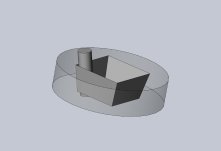99Panhard
Stainless
- Joined
- Feb 22, 2006
- Location
- Smithfield, Rhode Island
These are the "crosses" that connect the axle to the hub in my 1910 Mitchell. Making them has been onr of or likely the most challenging part I've ever done, largely because it took me two or three years, on and off, to think of a way to do it.
Each has 4 arms with a lug at the end having a 3-degree taper to go into a matching slot on the hub. As you can see, I've gotten to the point where I need the swuare hole in the center and that I have no good way to do. So, I'm looking to the pros for suggestions. I was thinking of EDM but, as yet, I've found no local company that does it, The truth is that I've gotten so much good advice through this forum over the last 10 years that I'd rather give the job to a forum member than someone I've never dealt with. I need two crosses...the third one will work but the dimensions are slightly off so I saved that as a spare and/or for set up. I also have one original piece that the dimensions of the hole can be taken from. The square is a nominal 1-1/8" with rounded corners. The original seems to measure .006 to .008 over but it's 120 years old so I can 't tell how much of this is wear.

Here is how they work...

Each has 4 arms with a lug at the end having a 3-degree taper to go into a matching slot on the hub. As you can see, I've gotten to the point where I need the swuare hole in the center and that I have no good way to do. So, I'm looking to the pros for suggestions. I was thinking of EDM but, as yet, I've found no local company that does it, The truth is that I've gotten so much good advice through this forum over the last 10 years that I'd rather give the job to a forum member than someone I've never dealt with. I need two crosses...the third one will work but the dimensions are slightly off so I saved that as a spare and/or for set up. I also have one original piece that the dimensions of the hole can be taken from. The square is a nominal 1-1/8" with rounded corners. The original seems to measure .006 to .008 over but it's 120 years old so I can 't tell how much of this is wear.

Here is how they work...



